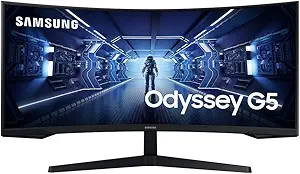In the realm of monitors, Dell and Samsung emerge as leading contenders, each boasting a rich history of innovation and a commitment to delivering cutting-edge display solutions. Whether you're a professional in need of color accuracy, a gamer seeking immersive visuals, or a casual user looking for reliability, the choice between Dell and Samsung monitors can significantly shape your computing experience. Join us as we embark on a journey to explore the distinctive features and strengths of both brands, aiding you in making an informed decision and finding the perfect monitor for your needs.
Key Features Comparison
Size
When it comes to the aspect of size in the category of monitors, both Dell and Samsung offer a wide range of options to cater to various user needs. Dell monitors range in size from smaller 19-inch models up to large 86-inch interactive touch monitors, making them suitable for everything from compact home office setups to large-scale business and educational applications. Samsung, on the other hand, provides monitors from 24 inches up to a whopping 98 inches, with their larger models primarily designed for commercial and professional use. In terms of technology, Dell's larger monitors often come equipped with features such as 4K resolution, IPS technology for wide viewing angles, and USB-C connectivity for added convenience. Samsung's larger monitors, on the other hand, often boast QLED technology for vibrant colors, 4K or 8K resolution for crisp images, and HDR10+ support for enhanced contrast and detail. However, it's worth noting that while both brands offer large monitors, Samsung's offerings tend to be more extensive in the ultra-large segment, particularly with their QLED TV range which can also function as monitors. Conversely, Dell's large monitor range is more focused on interactive touch models, which can offer added functionality in certain use cases.
Brand reliability
Dell and Samsung are two well-established brands in the monitor market, both known for their reliability. Dell monitors are recognized for their robust build quality, excellent warranty terms, and responsive customer service. They have consistently been at the forefront of introducing new technologies, such as 4K and 8K resolution monitors, and their UltraSharp series is highly regarded by professionals for its color accuracy and consistency. However, some users have reported issues with backlight bleeding on certain models, which could affect the overall viewing experience. On the other hand, Samsung monitors are known for their innovative technologies, such as Quantum Dot and Super Ultra-Wide displays. They also offer a wide range of options, from budget-friendly monitors to high-end gaming and professional displays. Samsung's customer service is generally reliable, and their warranty terms are competitive. However, there have been reports of quality control issues with some of their monitors, with users noting problems such as dead pixels or flickering screens. While these issues are not widespread, they do highlight potential reliability concerns. Compared to other brands, both Dell and Samsung have proven their reliability over time, but each has its own set of strengths and weaknesses that potential buyers should consider.
Affordability
Dell and Samsung are both renowned brands in the monitor market, offering a wide range of products with varying price points. Dell monitors are generally known for their competitive pricing, especially in the mid-range segment. For instance, the Dell Ultrasharp series provides excellent value for money, offering high-resolution displays and professional-grade color accuracy at a relatively affordable price. The brand also offers budget-friendly options like the Dell E Series, which are perfect for everyday use. However, some of the latest technologies like OLED displays and 4K resolution are reserved for their high-end models, which can be quite pricey. On the other hand, Samsung monitors are typically associated with premium pricing, but they justify this with superior technology and innovative features. The Samsung Odyssey series, for example, is a high-end line of gaming monitors featuring QLED technology, high refresh rates, and curved displays, which are priced higher than most Dell monitors. However, Samsung also caters to budget-conscious consumers with their S series monitors, which offer decent performance at a lower cost. Despite the higher price tag, Samsung monitors often edge out in terms of display technology, offering features like Quantum Dot technology and HDR10+ support even in their mid-range models. Compared to other brands, both Dell and Samsung offer competitive pricing, with Dell being more budget-friendly and Samsung offering more high-end features.
Reputation
Dell and Samsung are both renowned brands in the monitor industry, each with its own reputation for quality and innovation. Dell, for instance, has a solid reputation for producing reliable, high-performance monitors that are particularly favored by professionals and businesses. They are known for their impressive color accuracy, sharp image quality, and ergonomic designs. Dell's UltraSharp series, featuring the latest IPS technology, has been highly praised for its professional-grade performance. However, some users have raised concerns about the price point of Dell monitors, which tends to be higher than average. Samsung, on the other hand, is recognized for its cutting-edge technology and superior picture quality. Samsung's monitors, especially those from the Quantum Dot and Curved series, are highly regarded for their vibrant colors, deep contrasts, and immersive viewing experiences. The brand's innovative approach to monitor technology, such as the introduction of the world's first do-it-all screen, the M7, has further solidified its reputation in the market. However, Samsung monitors have occasionally been critiqued for their durability and longevity compared to other brands. In terms of reputation, both brands are highly respected, though they appeal to slightly different user bases due to their unique strengths and weaknesses.
Picture Quality
When it comes to picture quality, both Dell and Samsung monitors offer exceptional performance, but they do have their unique strengths. Dell monitors, particularly the Ultrasharp series, are renowned for their color accuracy and precision, making them a favorite among graphic designers and photographers. The latest models feature technologies like IPS (In-Plane Switching), which provides excellent color consistency across a wide viewing angle, and HDR (High Dynamic Range), which enhances the contrast between the darkest black and the brightest white. However, some users have noted that Dell monitors can have a slightly lower contrast ratio compared to other brands, which may affect the depth of the image. On the other hand, Samsung monitors are known for their vibrant and vivid display, largely due to their Quantum Dot technology and VA (Vertical Alignment) panels. The Quantum Dot technology allows Samsung monitors to cover a larger color spectrum, resulting in more saturated and lifelike images. Their VA panels also offer superior contrast ratios, producing deeper blacks and brighter whites. However, Samsung monitors can sometimes struggle with color accuracy, especially when viewed from different angles. In comparison to other brands, Samsung monitors tend to prioritize vibrancy and contrast over color precision.
Connectivity
Dell and Samsung are two of the leading brands when it comes to monitors, each offering a range of connectivity options to cater to various user needs. Dell monitors typically come with a variety of connectivity options including HDMI, DisplayPort, and USB ports. Some of the latest models also include USB-C ports, which allow for data transfer, display connectivity, and power delivery all through a single cable. This is particularly beneficial for users who want to streamline their workspace and reduce cable clutter. However, some users have reported issues with the reliability of Dell's HDMI ports over time. On the other hand, Samsung monitors also offer a range of connectivity options such as HDMI and DisplayPort. However, Samsung has been more progressive in incorporating newer technologies like Thunderbolt 3 ports, which provide faster data transfer speeds compared to traditional USB ports. This makes Samsung monitors a better option for users who frequently transfer large files. Additionally, some Samsung monitors also feature wireless connectivity options, allowing users to connect their devices without the need for cables. However, these advanced connectivity options often come at a higher price point, making Samsung monitors potentially less affordable than their Dell counterparts.
Production Selection
Dell and Samsung are two prominent brands in the monitor market, each offering a diverse range of products to cater to different user requirements. Dell monitors are known for their professional design, high-quality displays, and advanced features such as InfinityEdge and ComfortView, which minimize eye strain. Their product line includes models for general use, professional graphics, gaming, and more. Dell's Ultrasharp series, for instance, is highly praised for its color accuracy and resolution, making it a preferred choice for graphic designers and photographers. On the other hand, Samsung monitors are recognized for their innovative technology, sleek designs, and high-quality displays. Samsung offers a wide selection of monitors, including curved, gaming, and 4K UHD monitors. Their Quantum Dot technology, available in the QLED series, is particularly noteworthy for delivering more vibrant colors and sharper contrasts. Samsung's Odyssey series, designed for gaming, features high refresh rates and low response times, providing a smooth and immersive gaming experience. However, while Samsung monitors tend to have more innovative features, they can also be more expensive than Dell monitors, which offer a better balance between cost and performance.
Related Video
Conclusion
Dell and Samsung are two prominent brands in the monitor market, each with their own strengths and weaknesses. Dell monitors are known for their professional design, excellent color accuracy, and high-end features such as IPS panels, 4K resolution, and USB-C connectivity. They are favored in the business and professional sector for their reliability and performance. However, Dell monitors often come with a higher price tag compared to other brands and their gaming monitors may not be as feature-packed as those from brands that specialize in gaming. On the other hand, Samsung monitors stand out with their cutting-edge technology such as Quantum Dot (QLED) and High Dynamic Range (HDR), which offer vibrant colors and deep contrasts. Samsung's curved monitors are also among the best in the market, providing immersive viewing experiences that are ideal for gaming and multimedia consumption. However, Samsung's color accuracy may not be as precise as Dell's, making them less suitable for tasks that require color-critical accuracy such as graphic design or video editing. Additionally, while Samsung monitors generally have a sleek and modern design, their build quality can sometimes be inconsistent.


















